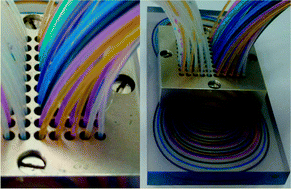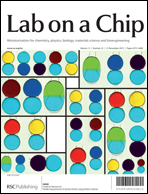Connecting microfluidic chips using a chemically inert, reversible, multichannel chip-to-world-interface †
Abstract
In this paper we present a reusable, chemically inert, multichannel Chip-to-World-Interface (CWI). The concept of this interface is based on a force fit connection similar to the hollow screw connectors known from high-performance liquid chromatography (HPLC) instruments. It allows contamination free connection of up to 100 thermoplastic tubes to microfluidic chips made from various materials e.g., epoxy polymers, glass and polydimethylsiloxane (PDMS). The spacing of the tubes is fixed whereas the outer dimensions of the CWI can be adapted to the microfluidic chip it should be used with. We demonstrate that such a CWI with 100 tubes is pressure-tight up to (at least) 630 kPa (6.3 bar) pressure and the connection easily sustains flow rates above 4 ml min−1. The presented CWI is designed such that the fluid probed in the microfluidic chip is in direct contact only with the tube material and the material from which the microfluidic chip is made. This not only enables fluid transport without dead volume, it also ensures that CWI itself will not be contaminated or contaminate the samples being probed. Using polytetrafluoroethylene (PTFE, Teflon®) tubing we demonstrate that the CWI can even be used with harsh organic solvents such as dichloromethane or dimethylformamide during continuous solvent probing over several hours without damage to the CWI or leakage. This CWI therefore effectively allows using almost all types of organic solvents in microfluidic applications.


 Please wait while we load your content...
Please wait while we load your content...